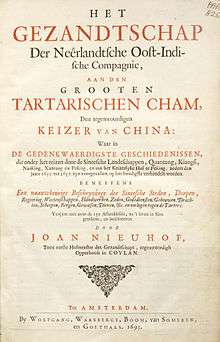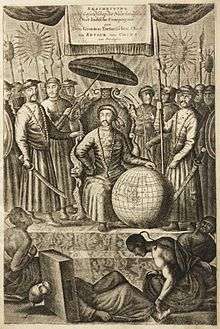An embassy from the East-India Company
An embassy from the East-India Company of the United Provinces is a book written by Dutch author and explorer Johan Nieuhof. The full title of the English version of the book is An embassy from the East-India Company of the United Provinces, to the Grand Tartar Cham, emperor of China: delivered by their excellencies Peter de Goyer and Jacob de Keyzer, at his imperial city of Peking wherein the cities, towns, villages, ports, rivers, &c. in their passages from Canton to Peking are ingeniously described by John Nieuhoff; Englished and set forth with their several sculptures by John Ogilby.[1] The book served as a major influence in the rise of chinoiserie in the early eighteenth century.
 | |
| Author | Johan Nieuhof |
|---|---|
| Original title | Het gezantschap der Neêrlandtsche Oost-Indische Compagnie aan den grooten Tartarischen Cham, den tegenwoordigen keizer van China |
| Translator | John Ogilby |
| Illustrator | Johan Nieuhof |
| Country | Netherlands |
| Language | Dutch |
| Subject | China |
| Genre | Travel literature |
| Published | 1665 (original in Dutch) 1669 (English translation) |
Publication history
The book was first published in Dutch in 1665 by Johan's brother Hendrik and the Amsterdam-based publisher and printer Jacob van Meurs. Its original title was Het Gezandtschap der Neêrlandtsche Oost-Indische Compagnie, aan den grooten Tartarischen Cham, den tegenwoordigen Keizer van China: Waarin de gedenkwaerdigste Geschiedenissen, die onder het reizen door de Sineesche landtschappen, Quantung, Kiangsi, Nanking, Xantung en Peking, en aan het Keizerlijke Hof te Peking, sedert den jaren 1655 tot 1657 zijn voorgevallen, op het bondigste verhandelt worden. Beneffens een Naukeurige Beschrijvinge der Sineesche Steden, Dorpen, Regeering, Weetenschappen, Hantwerken, Zeden, Godsdiensten, Gebouwen, Drachten, Schepen, Bergen, Gewassen, Dieren, et cetera en oorlogen tegen de Tartar : verçiert men over de 150 afbeeltsels, na't leven in Sina getekent.[2]
Because of the immense success it enjoyed, several other editions, albeit heavily edited and geared towards commercial interests, soon appeared. It was also translated into French, German, Latin and eventually into English in respectively, 1665, 1666, 1168 and 1669.[3] The English version was not published by Van Meurs, but by John Ogilby instead.
Content

The book consists of the notes and illustrations that Nieuhof made in his position as a steward on Peter de Goyer and Jacob de Keizer's embassy to the emperor of China. These notes and illustrations were left in the care of his brother Hendrik, "so as they not fall prey to rugged seas and hollow waves". This manuscript was eventually bundled and published to form this book, containing a written account of the embassy as well as 149 illustrations.
The work itself is split into two parts. The first part contains the written account of the embassy led by Peter de Goyer and Jacob de Keizer to the emperor of China. It details the entire journey from Canton to Peking and back again. This part also contains descriptions and depictions of all that the embassy came to pass on its trip. The second part consists of a general overview of China, wherein a variety of subjects comes to pass, containing descriptions and images of bridges, mountains, temples, customs, et cetera.[4] The work provides a total of 149 pictures, an unusual high number.
Importance of the work
Within the 'new' stream of information about China that began in the late seventeenth century, with reports of travel trade missions, An Embassy was a unique source. Especially the pictures marked a milestone in the history of the genre, because they were more realistic than before, providing both the real appearance of the Chinese people and their costumes. Prior to this period, the image of the Chinese in Europe was dominated by fantasy illustrations, already circulating for a number of centuries. Thus, this was the first work in a series of sources based not on fantasies, but on a direct representation of the Chinese life. Johan Nieuhof and his successors not only enhanced European knowledge about China, the pictures also gave an impetus to the growth of Chinoiserie in the arts. Many subsequent artists and architects based their work on Nieuhof's pictures.
Bibliography
- (in Dutch) Blussé, L. & R. Falkenburg (1987) Johan Nieuwhofs beelden van een Chinareis, 1655-1657. Middelburg.
- Sun, Jing (2013) The illusion of verisimilitude: Johan Nieuhof’s images of China, PhD dissertation Leiden University pdf
- Ulrichs, F. (2003) Johan Nieuhofs Blick auf China (1655-1657). Die Kuperstiche in seinem Chinabuch und ihre Wirkung auf den Verleger Jacob van Meurs, Sinologica Coloniensia 21, Harrossowitz Verlag Wiesbaden. ISBN 3-447-04708-9
References
- Nieuhof, Johan. "An embassy from the East-India Company of the United Provinces, to the Grand Tartar Cham, emperor of China; Englished and set forth with their several sculptures by John Ogilby". Jacob van Meurs. Retrieved 7 May 2014.
- Nieuhof, Johan (1665). "Het gezantschap der Neêrlandtsche Oost-Indische Compagnie, aan den grooten Tartarischen Cham, den tegenwoordigen keizer van China : waar in de gedenkwaerdighste geschiedenissen, die onder het reizen door de Sineesche landtschappen, Quantung, Kiangsi, Nanking, Xantung en Peking, en aan het keizerlijke hof te Peking, sedert den jare 1655 tot 1657 zijn voorgevallen, op het bondigste verhandelt worden : befeffens een naukeurige Beschryving der Sineesche steden, dorpen, regeering, wetenschappen, hantwerken, zeden, godsdiensten, gebouwen, drachten, schepen, bergen, gewassen, dieren, &c. en oorlogen tegen de Tarters : verçiert men over de 150 afbeeltsels, na't leven in Sina getekent". Jacob van Meurs. Retrieved 7 May 2014.
- van Meersbergen, Guido. "De uitgeversstrategie van Jacob van Meurs belicht: de Amsterdamse en "Antwerpse" edities van Johan Nieuhofs 'Gezantschap' (1665-1666)". Academia.edu. Retrieved 3 July 2014.
- Pos, Arie. "Het paviljoen van porselein : Nederlandse literaire chinoiserie en het westerse beeld van China (1250-2007)". Leiden University Libraries. Department of History, Faculty of Arts, Leiden University. Retrieved 3 July 2014.
| Wikimedia Commons has media related to Prints from Nieuhof Ambassade vers la Chine 1665 at the Peace Palace Library. |
| Wikimedia Commons has media related to Het Gezandtschap der Neêrlandtsche Oost-Indische Compagnie. |
See also
- External Links to copies of the book: On archive.org and on Digital Library for the Decorative Arts and Material Culture
- List of works about the Dutch East India Company